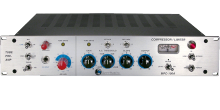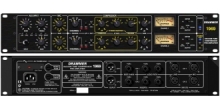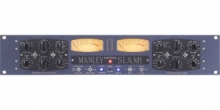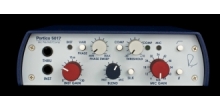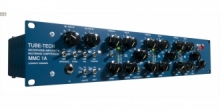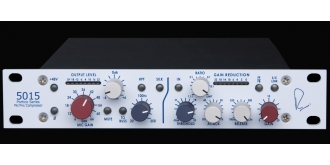 Agrandir l'image
Agrandir l'image
| Frequency Response Main Output,no load | -3dB @ 18Hz -3dB @ 160kHz |
| Noise: Measured at Main Output, unweighted,20Hz-22kHz, Terminated 150 Ohms |
With gain at unity better than -100dBu With gain at 66dB better than -62dBu |
| Equivalent Input Noise | better than -128 dBu |
| High Pass Filter Continuously variable swept frequency from 20Hz to 250 Hz |
slope ; 10dB/Octave |
| Gain | Unity to+66dB in 6 dB steps, Trim continuously adjustable from -6dB to + 6dB |
| Buss Output | Output is designed to feed a buss-mix Amplifier(ie. Buss inputs on 5043) at the internal systeme level -2.5dBu |
| Maximun Output Level | Maximun output from 20Hz to 40kHz is +24 dBu |
| Mute | Mutes Main Output only |
| Phantom Power | + 48 Volts DC +/- 1% |
| Total Harmonic Distortion and Noise | @ 1kHz,+20 dBu output
Main Output : Better than 0.002% @ 20Hz,+20 dBu output: Main Output : Better than 0.020% Silk Engaged : Better than 0.2% Second Harmonic |
| Compressor | |
| Gain Range | Continuously variable from -6dB to +20dB |
| Threshold Range | Continuously variable from -36dB to +22dB |
| Ratio Range | Continuously variable from 1.1:1 to "limit"(40:1) |
| Attack Range | Continuously variable from 20mS to 75mS |
| Release Range | Continuously variable from 100mS to 2.5 Seconds |
| FF/FB | Feed-Forward or Feed-Back VCA Control |
| Link | Multiple 5015's may be daisy-chained via the rear panel jacks. When an individual channel is engaged, its control voltage appears at the rear panel Link jack |
| Maximun Output Level : | Balanced and Floating Transformer Output +25dBu |
| Total Harmonic Distortion and Noise @2kHz, +20dBu output level,no load |
Main Output, compressor bypassed: Better than 0.001% Main Output, compressor engaged: Better than 0.06% |
| Noise: Mostly 2nd Harmonic Measured at Main Output,un-weighted,22Hz-22kHz,terminated 40Ohms |
With Gain at Unity, Compressor disengaged Better than -103dBu With Gain at unity Compressor engagegd : better than -92 dBu |
| Frequency Response | Main Output, Unity Gain @18 Hz-3 dB, @ 150kHz -3dB |
| 5015 Power | Voltage Range 9 to 18 Volts DC,12 Watts Connector : 5.5mm X 2.5mm DC jack, Center Positive Current consumption : @9VDC = 1.0 A typical @12VDC = 73mA typical @15VDC = 570mA typical @18VDC = 480mA typical |
RUPERT028M
Nouveau
RUPERT NEVE - Portico 5015

With independent transformer-coupled mic preamp and compressor-limiter sections identical to those found in the 5012 and 5043 modules, the fully analogue Portico 5015 combines the outstanding sound quality expected from a Rupert Neve design with the total flexibility required by modern recording studios. Available in both vertical and horizontal configurations, when used with the 5033 five-band EQ it is possible to create a Portico channel strip with preamplification, dynamics processing and equalization. As an additional routing option, the mic pre output may be routed directly to the compressor section without patching by pressing the To Comp switch.
The Microphone Preamplifier
The microphone input is balanced but not floating, using a Transformer-Like-Amplifier (T.L.A.) configuration with a toroidal Common Mode Rejection Low Pass Filter that excludes frequencies above 150 kHz. The T.L.A. is followed by an actual input transformer designed by Mr. Neve that permits a full +25 dBu input signal to be handled at unity gain without an input pad over the whole audio spectrum. This innovative solution combines the advantages of both an electronically-balanced and true transformer input.
In addition to the 72 dB of gain, the 5015 mic pre includes individually selectable phase, mute, phantom power, a swept high pass filter from 20-250 Hz, and the Silk circuit which yields the rich warmth and presence of the renowned classic designs.
The Compressor Section
The 5015's compressor has fully variable threshold, ratio, attack, release and makeup gain with two selectable VCA modes that provide for exceptional control of any source material.
To control gain, a V.C.A. or Voltage Controlled Amplifier (or Attenuator) is used. There are many types of voltage control devices, including tubes, discrete and integrated solid state circuits and naturally non-linear devices, each one having its own characteristic behavior that reflects sonically on the final performance, providing a character or signature that can be musically attractive (or not!). The Portico 5043 makes use of a very accurate, low noise, low distortion V.C.A. having essentially no signature of its own.
A part of the audio signal is rectified and smoothed to produce a suitable control voltage for the V.C.A., which has to respond very quickly and have low distortion. If the response is too fast, some of the signal will be unnecessarily gain-controlled. If the response is too slow, the signal will overshoot and the first few cycles will not get compressed. The speed and accuracy of the response - known as the "attack" - and the timeframe that gain remains under the initial control - known as the "release" or "recovery" - each play a large part in the way a compressor sounds.
LOW NOISE, LOW DISTORTION OPERATION
Much care was given in designing the 5015 to produce as little noise and non-harmonic distortion as possible. Carefully implemented signal paths and Class A operation are a large part of the 5015's sweet, whisper-quiet performance.
All Portico modules use input and output transformers and almost entirely discrete component amplifiers. In fact, the Line amplifiers on their own, inserted into the signal chain, are capable of enhancing the sonic quality of many signal sources, especially those of digital origin. These are some of the factors that enable the Portico 5015 to work so unobtrusively within the context of a very high quality audio chain.
Why Transformers?
The fine subtleties of circuit design relating to sonic performance are gradually becoming more clearly understood. For example, research has shown conclusively that frequencies above 20kHz affect the way in which humans perceive sound quality. But long before scientific evidence emerged, a substantial body of musicians and engineers knew that equipment with apparently the same technical measurements could sound very different.
Incredibly small amounts of musically dissonant odd harmonics can have a disastrous effect on the sound quality. Extraneous noise or interference that finds its way into a signal path seriously impairs performance of the whole chain. Since many control rooms make use of outboard gear that is not well protected from external signals, poor grounding of such equipment can be a serious problem. "Electronically balanced" circuits, much-used in modern equipment, can give very good measurements on the test bench but they do not provide adequate rejection of the stray fields found in every working environment.
To correct these issues, input and output circuits must be freed from ground dependence so that only the wanted signal enters and leaves the processing path. Transformers are the ideal solution. The sweet and silky sound of Mr. Neve's classic designs was achieved with big transistors and large high quality transformers. Rupert Neve Designs' Portico modules achieve similar quality today without the bulk or the cost.
In order for modules to work together as would be expected (i.e. in a proprietary console configuration) without producing hum, R.F. interference, or other interactions, the connecting interfaces, grounding, levels and impedances must receive careful attention. Each Portico module is a complete integral signal processor that delivers its specified performance independently. This is why we use transformers.
Silk
Much could be written about this feature, suffice to say, that it gives a subtle option to enhance
sound quality in the direction of vintage modules. The Silk button reduces negative feedback and
adjusts the frequency spectrum to provide a very sweet and musical performance. We suggest you
try it and make your own judgment.
Level Meter
-30 dBu to +22 dBu
With reference to the output
Mute
Cuts of the output signal post metering. Be sure to mute the outputs before engaging phantom power.
High Pass Filter
The High pass filter is a valuable aid in any signal chain but particularly so in a microphone
preamplifier. Signals between 20 and 250 Hz can be attenuated, leaving the range above this
unaffected. This gets rid of building rumble, air handling motor hum etc.
Phantom Power
Provides 48V phantom power to microphones
Phase Inverts
Flips the phase of an incoming source 180 degrees
COMPRESSION
For signals below the "threshold" level that has been set, a compressor provides a linear path allowing signals to be amplified without the gain being adjusted in any way. When signals exceed the "threshold" level, the gain is reduced in a controlled manner that depends on the Ratio that has been set.
GAIN
GAIN range provided is from -6dB to +20 dB. ?As already noted, when compression has taken place, it may be necessary to increase the overall gain to restore the apparent program level
RATIO
Range from 1:1 to LIMIT (i.e. 40:1)
Threshold
Range from -30dBu to +20dBU
ATTACK TIME
Range from 20 mS to 75 mS.
RELEASE / RECOVERY TIME
Range of RELEASE time is 100 mS to 2.5 Seconds.
STEREO Operation
When the LINK Push-Button is engaged on two channels of Portico compressors connected via the link inputs set to approximately the same values, gain reduction on both channels will be the same to preserve Stereo balance and center imaging.
DUCKING
When the LINK Push-Button is engaged and the link input is connected to another Portico series compressor with LINK engaged, the signal passing through one the compressors, may be used to control the amplitude of the Portico compressor its connected to.
REDUCTION METER
A reduction LED METER is provided that show GAIN REDUCTION in the compressor.
REDUCTION is calibrated in dB covering the range -1 to -22 dBu, reading from right to left,
Features And Specs
| Frequency Response Main Output,no load | -3dB @ 18Hz -3dB @ 160kHz |
| Noise: Measured at Main Output, unweighted,20Hz-22kHz, Terminated 150 Ohms |
With gain at unity better than -100dBu With gain at 66dB better than -62dBu |
| Equivalent Input Noise | better than -128 dBu |
| High Pass Filter Continuously variable swept frequency from 20Hz to 250 Hz |
slope ; 10dB/Octave |
| Gain | Unity to+66dB in 6 dB steps, Trim continuously adjustable from -6dB to + 6dB |
| Buss Output | Output is designed to feed a buss-mix Amplifier(ie. Buss inputs on 5043) at the internal systeme level -2.5dBu |
| Maximun Output Level | Maximun output from 20Hz to 40kHz is +24 dBu |
| Mute | Mutes Main Output only |
| Phantom Power | + 48 Volts DC +/- 1% |
| Total Harmonic Distortion and Noise | @ 1kHz,+20 dBu output
Main Output : Better than 0.002% @ 20Hz,+20 dBu output: Main Output : Better than 0.020% Silk Engaged : Better than 0.2% Second Harmonic |
| Compressor | |
| Gain Range | Continuously variable from -6dB to +20dB |
| Threshold Range | Continuously variable from -36dB to +22dB |
| Ratio Range | Continuously variable from 1.1:1 to "limit"(40:1) |
| Attack Range | Continuously variable from 20mS to 75mS |
| Release Range | Continuously variable from 100mS to 2.5 Seconds |
| FF/FB | Feed-Forward or Feed-Back VCA Control |
| Link | Multiple 5015's may be daisy-chained via the rear panel jacks. When an individual channel is engaged, its control voltage appears at the rear panel Link jack |
| Maximun Output Level : | Balanced and Floating Transformer Output +25dBu |
| Total Harmonic Distortion and Noise @2kHz, +20dBu output level,no load |
Main Output, compressor bypassed: Better than 0.001% Main Output, compressor engaged: Better than 0.06% |
| Noise: Mostly 2nd Harmonic Measured at Main Output,un-weighted,22Hz-22kHz,terminated 40Ohms |
With Gain at Unity, Compressor disengaged Better than -103dBu With Gain at unity Compressor engagegd : better than -92 dBu |
| Frequency Response | Main Output, Unity Gain @18 Hz-3 dB, @ 150kHz -3dB |
| 5015 Power | Voltage Range 9 to 18 Volts DC,12 Watts Connector : 5.5mm X 2.5mm DC jack, Center Positive Current consumption : @9VDC = 1.0 A typical @12VDC = 73mA typical @15VDC = 570mA typical @18VDC = 480mA typical |




